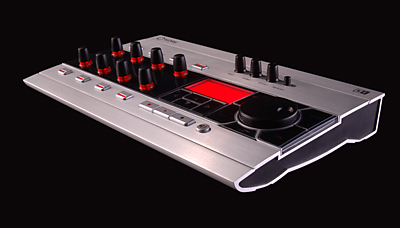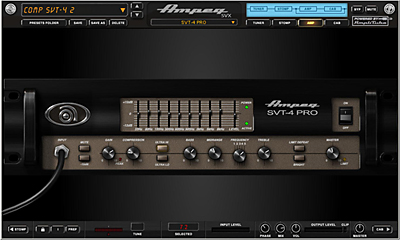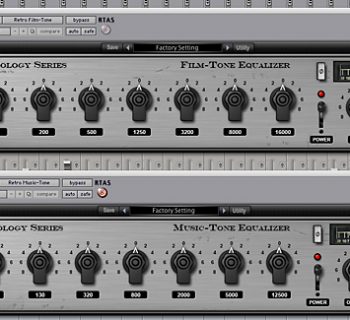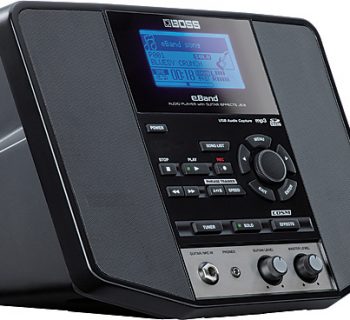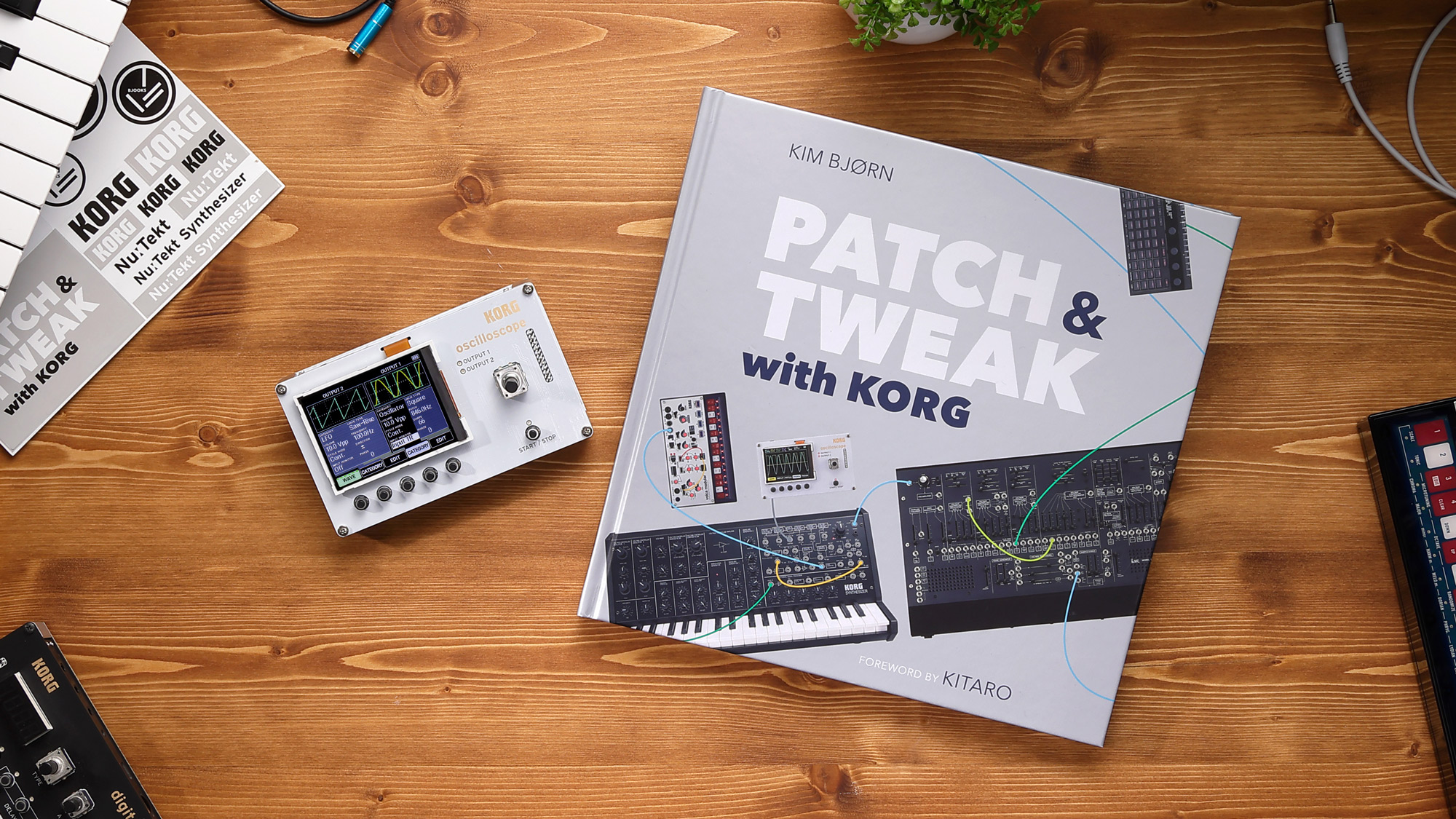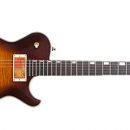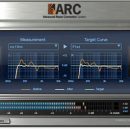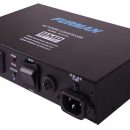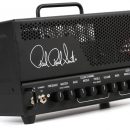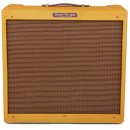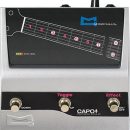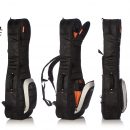Native Instruments has decided that they are not satisfied with just being part of the virtual realm. Now they want to take on the audio interface/controller world as well. Riding closely on the heels of their first hardware release (Rig Kontrol for Guitar Rig), the product under the microscope today is KORE, a hardware/software combination that functions as a standalone host for running software plug-ins.
| Category | Value | Rating |
| Features | 20% | |
| Usability | 25% | |
| Sound | 25% | |
| Documentation & Support | 10% | |
| Price | 20% | |
| OVERALL RATING = 3.5 3.6 stars or better: Outstanding, WIHO Award 3 stars or better: Worth considering 2 stars or better: Suited to specific needs 1 star or less: Not recommended |
||
KORE is a software/hardware concept that takes some explaining. The software side is basically a shell for all of your soft synths and plug-in effects. It allows for combining these to form new sounds and virtual instruments. The sounds are not bound to the host application, but rather to the KORE software itself. And because KORE can be loaded as a plug-in into almost any sequencer, it makes for easy travel of multi-layered sounds between programs.
The hardware is a cross between a MIDI controller and an audio interface. Although this concept has been tackled before, Native Instruments has upped the ante by including 360 degree, touch-sensitive rotary knobs and a clear screen so that it's easy to see what is going on without looking at your computer monitor every five seconds. It should be noted here that while the KORE controller is similar to a MIDI controller, it isn't a MIDI controller. But more on that later...
Native Instruments may have hit another home run with this product, though KORE is still in need of a few finishing touches to yield perfection. The initial batch of KORE packages flew off the shelves so quickly that Native Instruments was immediately back-logged, and it took us longer than expected to get our demo unit. But the wait was well worth it, and we dug in quickly to find out what this product could do for you.
Overall KORE exceeded our expectations. It is a one-of-a-kind hardware/software combination that will find a good home in many studios and live rigs. The hardware looks cool and is built well. The software brings a much-needed universality to the world of soft synths.
The only real detracting points we found during our review of KORE were few: the hardware buttons are a bit clunky, and the headphone output doesn't mirror the main output. As far as the buttons go, it's not really a big issue – just a minor annoyance. And as soon as you get into making sounds, you'll probably forget about it anyway. The headphone jack is a bigger hindrance though because it makes it difficult to switch easily between monitor speakers and headphones while using a sequencer. More about this in the Usability section.
Additionally, we experienced a few crashes while running KORE that while inconvenient in the studio, would be significant problems for musicians using KORE in a live performance environment.
Native Instruments continues to refine and update the KORE software, so we’re expecting this product to continue improving in all areas.
Features
Not to be confused with products like Muse Receptor VST (a stand-alone soft synth player), KORE must be run from a computer. It can function as a stand-alone application for organizing your virtual instruments or it can run as a plug-in from within most audio applications. Because the KORE plug-in is available in multiple formats, it can (for example) host VST instruments while the KORE RTAS plug-in runs inside of Pro Tools LE without the need for separate VST-to-RTAS adapters.
SOUND-OFF
If you have Native Instrument's Komplete 3 already installed on your computer, finding the sound you want is a snap with KORE's Browser function. Sounds are grouped by category/characteristic, and there are five groups to choose from: Instrument (the instrument itself – Piano, Organ, Synth, etc.), Source (how the sound is generated – Acoustic, Electric, Analog, Digital, etc.), Timbre (color of the sound – High, Low, Distorted, etc.), Articulation (Attack – Sustain, Decay, Percussive, Pulsating, etc.), and Genre (style of music the sound may be best suited for – House, Techno, Rock, Pop, etc.). A list is given to choose your sound from, and every time you click on a new category, the list is shortened.
In the past, manufacturers have grouped sounds according to category (piano, strings, bass, synth, etc.) but this is the first time the idea has been taken this far and to this degree. KORE's Browser is very intuitive and provides so many sound-searching tools that it really simplifies the process of auditioning sounds. If you are familiar with the Apple Loops browser in Apple Computer’s Logic Pro 7 or the interface within Garage Band, you will find this intuitive interface immediately familiar.

Sounds can also be found by searching for them by name or keyword (just like on the Internet). Plug-ins can also be loaded traditionally (like you would in a normal sequencer), and sounds can be found within the instrument itself.
Native Instruments say that as the KORE format becomes more popular, they expect more third-party companies to begin making their instruments “KORE Kompatible,” which basically means that the manufacturers will add metadata to their instrument sound libraries for automatic inclusion within the Browser interface. With third-party plug-ins, you currently have to tag/key the sounds manually if you want them to be locatable through the fantastic Browser interface.
KONTROL YOURSELF
The KORE hardware offers great control over soft synths. With eight 360-degree, touch-sensitive knobs and eight buttons, it covers most of the bases needed to really get a hand on your synths. The hardware also allows access to the Sound and Performance Browser, so you can find your sounds and control them without touching your computer. This makes live play very fast and comfortable.
But wait. 360-degree knobs? Touch sensitive? What is this all about?
This is one feature that makes KORE very cool indeed. Because KORE is not a standard MIDI controller, it isn't restricted to 128 steps for parameters. In fact, the knobs have a 500-step resolution, are big and comfortable, spaced well apart for large fingers, and they turn very smoothly. The 360-degree movement refers to the unlimited rotation they have, which allows them to pick up effect settings and change them no matter where they are.
For example, imagine that you have a lowpass filter and the cut-off frequency is completely open. On a traditional MIDI controller, if your control knob is turned all the way to one end of the spectrum when you go to turn the knob, there's going to be a nasty jump in the frequency of the sound. With the KORE knobs, all you have to do is twist, and rest assured that there will be no jumps – just clean, smooth filter sweeping.
Touch sensitive is another great feature in the KORE hardware, almost, dare we say, sci-fi? How many times has this happened: There sits your controller, it's all ready to go and your song is bumping along, but then you forget which knob controls Attack time on Envelope 1! If you've labeled everything correctly this probably won't happen to you, but who has time to label things? Especially when you're controlling ten synths with one controller. Well, the old way to do it was to just twist each knob a little bit (and hope nothing drastic happened) until you found the right one. Not anymore!
With KORE's touch-sensitive knobs, all you have to do is touch the knob and the screen tells you what you're about to control. Very cool. Right now you may be thinking that KORE hardware is a straight-up MIDI controller, but you would be mistaken. The KORE hardware can only control instruments that are used within its software. So, any plug-in you have loaded into KORE can be controlled (as long as it can be automated in a sequencer), but you can't control non-plug-in parameters. For example, sequencer fader levels cannot be controlled by the KORE hardware. And if you have any proprietary plug-ins that only work within a specific sequencer (in other words, they aren't VST or Audio Unit plug-ins), you can't control their parameters either.
ON THE ROAD AGAIN...
One of the best features about KORE is that it makes it easy to take sounds from one sequencer to another. It is compatible with Audio Unit and VST plug-ins, and can run inside of most major sequencers (VST, AU, RTAS, and DXi). It is worth noting that when run within Digidesign Pro Tools as an RTAS plug-in, KORE acts as a 'wrapper' shell for VST and AU plug-ins and allows these to be used with Pro Tools. This enables sounds to be exchanged between programs easily and quickly. Sounds can also be easily recalled in the studio or on the stage using the software and hardware combination in Standalone mode. This breaks down the barrier between live play and studio play when it comes to computers.
Here's a quick example. Suppose that you want to have a piano sound from NI’s Akoustik Piano layered with a string sound from FM7 beneath it. Create a new KORE sound and load in the Piano and the String sound you want. Now play. Not so mind-blowing, right? Pianos and strings… Sure, this can be done in any sequencer with decent MIDI capabilities. Fair enough. But what if you want to have a Bass in the left hand and your wonderful Piano/String layer in the right? Well, simple! Just throw a Bass into the mix and adjust the keyboard mapping. With a traditional sequencer and multiple soft synths, this would be a significantly more complex task to accomplish.

Now, what if you want to take this sound and play it live? Well, because you saved it as a KORE Sound it is easy to recall when KORE is in Standalone mode and play it anywhere, with or without a host sequencer.
Further, what if you made the song in Digidesign Pro Tools but you want to play with it in Ableton Live? This is simple with KORE because it can be opened as a plug-in in both programs, and the sound you created can be played anywhere KORE can run. Pretty cool, huh?
MASTER OF YOUR DOMAIN How many times have we all wanted to set up massive keyboard patches using our soft synths just like we do with our workstation synths? Have you ever wanted to create lush multi-layers for live performance? Well, now you can!
Like in the example above, KORE software makes it easy create and combine patches, and also set up keyboard splits and layers with multiple sounds. These sounds can be saved and given their own categories for future look-up and retrieval.
The software side of KORE is very similar to the Combinator in Propellerhead’s Reason 3.0 in many ways. What makes KORE so cool though is its ability to combine multiple plug-ins from different manufacturers into one sound and access that sound from any sequencer.
READY FOR THE CLUB
KORE's hardware also doubles as a USB 2.0 audio interface with two inputs and four outputs. We'll talk more about this in the next section, but it should be mentioned here that the headphone jack can be assigned to outputs three and four. This is cool because it allows the auditioning of sounds over headphones, much like a DJ would audition records. In fact, this is useful with programs like NI’s Traktor DJ Studio or Ableton Live when laptop DJ-ing.
UPDATES
Since we first began writing this review, Native Instruments released version 1.0.2 of the KORE software. Included in this must-have update are more effects and a "Live" view. The new effects include much-needed compressors (Easy Comp, Limiter, and Multi Comp), a filter bank, and two sound degraders (Lo-Fi and Freq Shifter). These effects are a welcome add-on, as one of the few complaints we had about the initial release was the absence of a compressor. Thanks, Native Instruments! Documentation was also updated.
The other major update is the addition of a Live view. Native Instruments had promised this feature in the very beginning. Essentially the Live view is a larger, easier to read screen that shows the basics of a set. In this view, there is no editing of the sounds, but you can switch between sounds easily and see what is going on with the knobs.
Future updates are already hinted at, with some buttons in the interface not being operable at this time (for example, when trying to set the fade time between patches, the button marked "Beats" just brings up a window saying that this feature will be introduced in a later version).
Usability
KORE is extremely flexible and usable as both a soft synth shell and a hardware audio interface. The software has many features that make it unique and desirable in the music production world. It's so easy to call up and try out new sounds that making music with KORE is really fun.
We installed KORE 1.0.2 on a dual-processor Apple PowerMac G5 running OS X 10.4.5. KORE’s internal database contains information that tells it how to categorize sounds from most of NI's product line, but it doesn't automatically know that sound "XX" from your Access VST should be categorized as ethereal, pad, sequenced, etc. Fortunately, the KORE application made it very easy for us to add classification metadata to the sounds from our third-party soft synths. Through a point-and-click process, we were able to go through the hundreds of presets in our Access VST and add them to the KORE database for easy reference in the future. Of course, after five hours of categorizing presets, we lost all musical inspiration and decided to go for a swim.
This is where other companies will help by making their products KORE Kompatible – providing the categorization information for use with KORE so that you don't have to do it. Some companies have already jumped on the bandwagon, and you can find a complete list at Native Instruments' website.
The hardware works very well. Its knobs are comfortable to the touch and the screen is easy to see in all kinds of lighting situations. Unfortunately, as we already mentioned, the hardware isn't a traditional MIDI controller, so it can't control everything… yet! We’re hopeful that a future software upgrade will introduce more control possibilities.
There are only two real complaints we have, and both center around the hardware. The first is not too serious: While the knobs work great, the buttons on the panel are a bit clunky and hard to press. After a short time of working with the device, we got used to them, but it would be nice to have something this sexy sporting better buttons that are a little bit more comfortable.
The other issue is a bit more problematic: the headphone output. The headphone output does not mirror the main outputs, so if you have a sound running through your monitors, you can't just turn down the output knob and turn up the headphones – you won't hear anything! Within the KORE program itself, this can be worked around by using the Pre Fader Levels (PFL) button, as long as the PFL is assigned to outputs 3/4 in the Audio/MIDI setup. But if you're using the KORE hardware with a sequencer like Logic Pro or Ableton Live, everything has to be run through outputs 3/4 to be heard through the headphones. This really makes it hard to use KORE as a primary audio interface in a home studio where you'll frequently need to switch between the headphones and monitors.
Although the KORE hardware does have two inputs, they are both 1/4", with no XLR input for a microphone. This would be a nice addition for a future model.

Latency is one issue that creeps up when talking about audio interfaces. Happily, the KORE controller had no issues putting out loads of sound. We were able to play heavy-duty sounds from the Reaktor library with no latency problems.
At this time there are still a few kinks to be worked out with the whole KORE system. Occasional crashes and hangs slowed down production slightly, which makes us hesitant (for now) to recommend using KORE in a live performance environment. Hopefully, NI will continue to refine the KORE software and improve its reliability.
As we were finishing up our review, one of the knobs on our KORE controller malfunctioned and began sending out constant random data, rendering the unit unusable – it isn’t possible to turn the knobs and maneuver through the menus at the same time. Although we could still use the software without any problems, the hardware was reduced to an audio-interface-only with none of its control capabilities until a new unit could be obtained from Native Instruments.
As for our features and usability wish-list, we hope that a future update will include basic transport functions. As of now, although there are Stop, Play, and Record buttons, these currently have no apparent function.
Sound
The sound output on the KORE hardware is fine both from the main outputs and the headphone outputs. It is very clean, with no buzzing or humming from the connection to the computer. The software sounds as good as the plug-ins you have running through it.
Documentation and Product Support
Like most other Native Instruments manuals, the one for KORE goes over basic features and has a short tutorial to help get started. It is mostly to the point and doesn't get too confusing. The software itself can be a little confusing at times, but the manual does cover all the bases nicely.
Price
KORE (MSRP $559) has a street price of $499.99 – a little on the pricey side for a piece of utility equipment. True, it is a software/hardware combination, but it doesn't actually come with any sounds straight out of the box. It would be a nice addition to include a scaled-down version of Reaktor (like Dynamo) so customers can have something to play with straight out of the box if they don't yet own any other soft synths.
If you’ve already made a significant investment in soft synths, though, KORE offers an excellent value proposition given its usefulness.
Contact Information
Native Instruments
www.native-instruments.com
| Evaluation Short-List |
|

